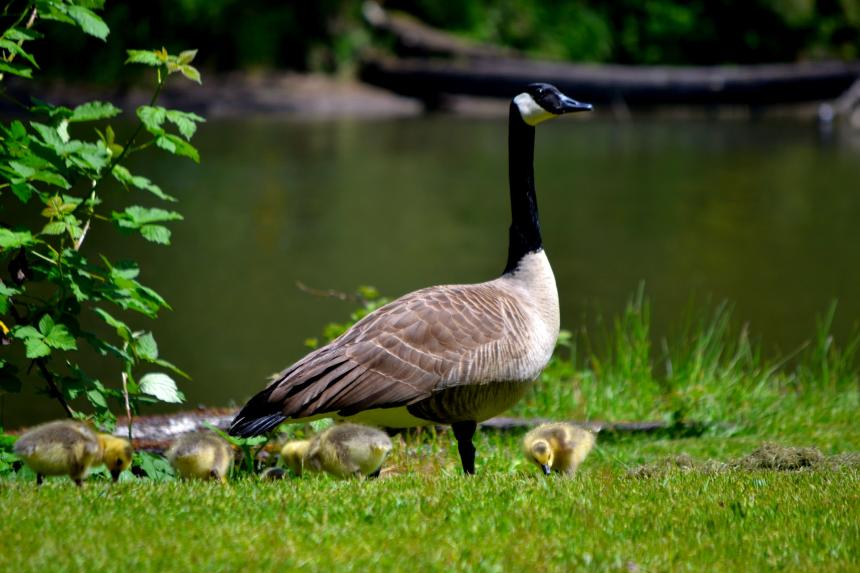Canada geese (Branta canadensis) are among the most familiar birds in Washington. They are a source of recreation for bird watchers and hunters and symbolize nature for many people. No one can miss the clear honking call of Canada geese when they fly overhead in their V-shaped formation.
Description and Range
Physical description
The Western Canada goose has a black head and crown, a long black neck, and white cheek patches that connect under the chin. The adult gander (male) tends to be bigger than the goose (female) and averages 30 inches in length with a 60-inch wingspan.
Geographic range
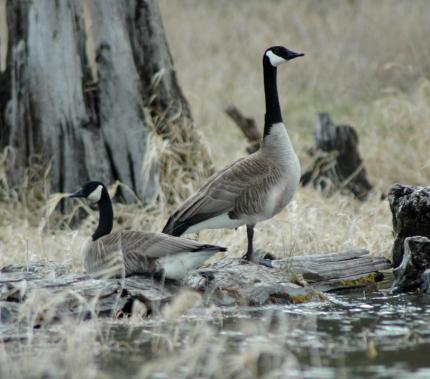
Two groups of Canada geese populate Washington—migrating geese and nonmigrating (often called resident) geese. For a goose to migrate, it must be taught the flight path by its parents. Therefore, all following generations of nonmigratory Canada geese will also be nonmigratory, or resident geese, which will stay year-round in the vicinity where they were born.
Populations of resident Canada geese have dramatically increased over the past 25 years, particularly in urban areas where there are few predators, prohibitions on hunting, and a dependable year-round supply of food and water.
Canada geese are particularly attracted to mowed lawns around homes, golf courses, parks, and similar areas next to open water. Because geese and people often occupy these spaces at the same time of the year, conflicts arise. Many citizens enjoy the presence of geese, but others do not.
Several subspecies of Canada geese breed or migrate through Washington. Their taxonomy has been confused by the introduction of mixed subspecies, and will likely remain unclear for a long time.
The Western Canada goose (Branta canadensis moffitti, Fig. 1) is the largest resident subspecies, referred to in the following as Canada geese, or geese.
Living with wildlife
Facts about Washington’s Canada Geese
Food and Feeding Habits
- Canada geese graze while walking on land, and feed on submerged aquatic vegetation by reaching under the water with their long necks.
- Wild food plants include pondweed, bulrush, sedge, cattail, horsetail, clover, and grass; agricultural crops include alfalfa, corn, millet, rye, barley, oats, and wheat. Geese also eat some insects, snails, and tadpoles, probably incidentally.
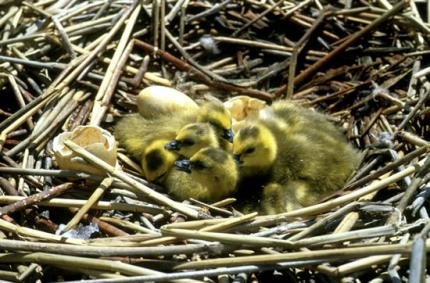
Nests and Nest Sites
- Canada geese nest in areas that are surrounded by or close to water (Fig. 2).
- Nest sites vary widely and include the shores of cattail and bulrush marshes, the bases of trees, the tops of muskrat lodges and haystacks, and unoccupied nests of eagles, herons, and ospreys. Nests have produced successful broods of geese and ospreys in the same year.
- Other nest sites include planter boxes and nesting structures provided specifically for geese.
- The nest is a bowl-shaped depression approximately 1½ feet in diameter lined with grass, leaves, and goose down.
- A pair of geese may return to the same nest site in consecutive years.
Reproduction
- Canada geese usually begin nesting at three years of age.
- Adult pairs usually stay together for life unless one dies. Lone geese will find another mate, generally within the same breeding season.
- Between one and ten, but normally five to six eggs are laid in the nest in March, April, or May. Eggs are incubated by the goose (female) while the gander (male) stands guard nearby. The female leaves the nest only briefly each day to feed.
- Eggs hatch after 25 to 30 days of incubation. The young, called goslings, can walk, swim, and feed within 24 hours.
- Both parents (especially the gander) vigorously defend the goslings until they are able to fly, which is at about ten weeks. The young geese remain with their family group for about one year.
- If the nest or eggs are destroyed, geese often re-nest in or near the first nest. Canada geese can raise one clutch per year.
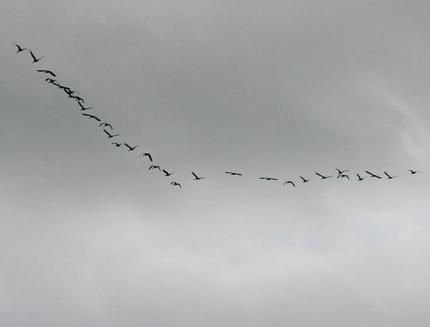
Longevity and Mortality
- Predators of Canada geese and their eggs include humans, coyotes, raccoons, skunks, bobcats, and foxes, as well as gulls, eagles, crows, ravens, and magpies.
- Canada geese hatched in urban environments may have very low first-year mortalities due to the abundance of food and relative scarcity of natural predators.
- Canada geese can live more than 20 years in captivity; in the wild they have a much shorter life span.
Viewing Canada Geese
Geese are among the few water birds that will tolerate the environmental conditions found in urban areas. They are often the largest and most conspicuous bird species that people see.
Geese are often seen in a V-shaped formation when flying (Fig. 3). Such a formation allows each trailing bird to receive lift from the wingtip vortex of the bird in front of it, saving energy and greatly extending the range of a flock of birds over that of a bird flying alone. Scientists have suggested that flying in V-formation may also be a way of maintaining visual contact and avoiding collisions.
Displays
Visit nearly any body of water in a nearby park (especially during the breeding period) and you will likely observe several obvious visual displays within a large active flock (Fig. 4).
The alert display (a) is given when a goose is wary of some danger. The neck is vertical and straight and the head is horizontal.
The bent-neck display (b) is given in conflict situations with other geese. The neck is coiled back and the head is lowered and pointed toward the opponent. This display may be accompanied by a hiss.
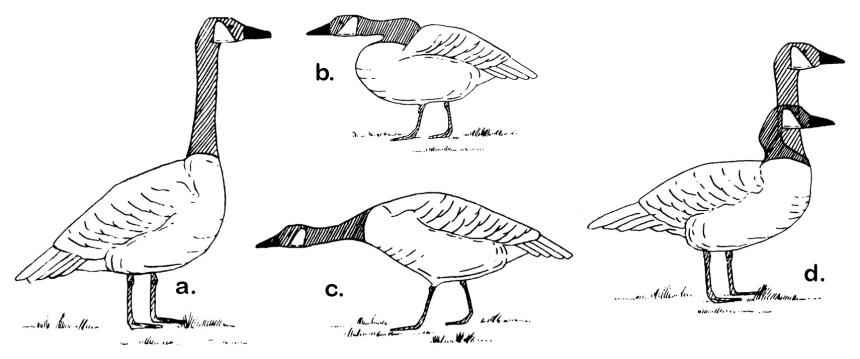
Nest Sites
Early in the breeding season, watch for a pair of geese quietly exploring an area. Later, listen for the honking call, which may be geese either greeting each other or engaging in a territorial squabble. Also, look for a lone male, feeding or resting, who is aggressive toward other geese or to you. Chances are its mate is on a nest nearby.
Because Canada geese are aggressive defenders of their nests and young, do not approach too closely; they may charge, and can inflict bruises with their beaks and wings.
Molting
Like most waterfowl, adult Canada geese go through a complete molt every year. Molting is an opportunity for geese to replace their worn, frayed, or lost feathers with new ones. The molt takes 30 to 45 days and is completed by mid-July, a time when the adult geese are free from activities such as nesting, brood rearing, and migrating.
The young are still with the adults during the molt, and at this stage none of the family can fly—the young because they haven’t grown their full flight feathers and the adults because they are replacing their flight feathers. Thus, the birds often move to areas that provide adjacent water for escape opportunities.
By late summer all of the family can fly, and they move to areas where there is abundant food, joining with other geese to form large flocks.
Calls
The typical goose ahonk, ahonk, ahonk call is given during aggressive encounters, as a greeting, and when calling a mate. The call of the male is thought to be lower than that of the female, and when a pair flies overhead, you may be able to distinguish the two sounds.
A hiss-call is given when geese are defending their territories, their nests, or their young, and is usually given only at close distances.
Tracks
Canada goose tracks are often seen on mudflats in conjunction with their sausage-shaped droppings. Their feet turn inward when they’re walking. The foot’s three main toes fan out in front and are connected by webs (Fig. 5). The claws are broad and blunt, and their imprint can usually be seen.
Droppings
Droppings are cylindrical and five to eight times longer than wide. Fresh droppings are greenish and coated with white nitrogenous deposits. Older droppings are darker.
Because geese have a rudimentary digestive system, they eat often and expel undigested remains in short order. Adult geese produce 1 to 3 pounds of droppings per day per bird.
Preventing conflict
Canada geese are extremely adaptable. They use food and other resources present in urban landscapes for nesting, raising young, molting, feeding, and resting. This has led to increasing conflicts between geese and people.
In parks and shorelines with short grass, large flocks of geese can denude areas of vegetation and litter them with their droppings and feathers. Public swimming areas used by many geese have been closed to swimming (see Public Health Concerns). When nesting, geese can be aggressive toward humans, and may “attack” people who come near their nests or young.
In public areas with favorable habitat, it is rarely desirable, or possible, to eliminate geese entirely. Ideally, management programs should strive to reduce goose numbers and related problems to a level that a community can tolerate.
No single, quick-fix solution is likely to solve conflicts with geese. An integrated approach using several of the techniques described below in combination is required. Any approach to controlling geese ideally should be in place before the conflict starts—or quickly thereafter—as it is much more difficult to discourage geese after they have become attached to a site. After nesting has started, moving or scaring geese off a nest is illegal.
To prevent conflicts or remedy existing problems
Stop feeding geese
When the diets of geese are no longer supplemented with handouts and they have to depend on the natural food supply, some or all the geese will move elsewhere.
In public areas, it is helpful to first install interpretive signs explaining the problems caused by feeding geese. Such signs might include the following in their text, preferably in the appropriate languages:
- Please don’t feed the geese!
- Human food is not good for the geese because it lacks proper nutritional value.
- Feeding attracts more geese than the area can support naturally.
- Geese in high concentrations are more likely to get diseases and parasites.
- Geese droppings harbor parasites that can cause human health problems.
- Goose droppings increase algae growth that, in turn, results in fish kills.
- Goose droppings are unsanitary, unsightly, and contain parasites irritating to humans.
- Geese eat plants needed for ground cover and erosion control.
- Too many geese in one area may force the municipality to have them killed.
- Goose-management costs taxpayers money.
In order to prevent well-intentioned people from feeding geese, some localities may need to pass ordinances to regulate feeding and create authority to enforce such regulations.
Lawn management
Evolutionarily, Canada geese are tundra nesters that prefer to congregate on low vegetation adjacent to open water (Fig. 7). Thus, areas of lawn next to water often attract geese. Large lawns provide food to graze on, room to take off and land, and an unobstructed sight line to scan for potential predators.
Although it can be expensive to transform a large lawn into something else—such as a play area or a landscape made up of plantings other than grass—it is the best long-term solution to human/goose conflicts. Such a transformation can occur over time and in phases; fencing or repellents may be necessary while the new landscape is getting established.
One important modification to a large area of lawn is to reduce its size to the point where geese no longer feel safe grazing on it. An open sight line (the distance from the geese to a place where a predator could hide) of less than 30 feet will generally cause geese to move to a more comfortable grazing area.
Any size lawn can be made less attractive to geese by increasing its growth height to 6 inches and reducing the number of tender new shoots it produces. Stopping fertilizing and watering will reduce both the palatability of the lawn and the time it takes to maintain it. (The grass can be maintained at any height with a weed-whacker.) All of the lawn—or only a wide portion bordering a body of water—can be maintained this way.
Barriers
Barriers are most effective when geese numbers are low, when geese are molting (not flying), and when the barrier is in place before geese begin using the area.
Low barriers may not deter flying geese from entering an area. However, since geese typically do not land in an area that is less than 30 feet wide, barriers, or lines of vegetation, can be used to break a site into smaller spaces. Low barriers can be combined with above-ground grids to prevent flying geese from accessing planted areas.
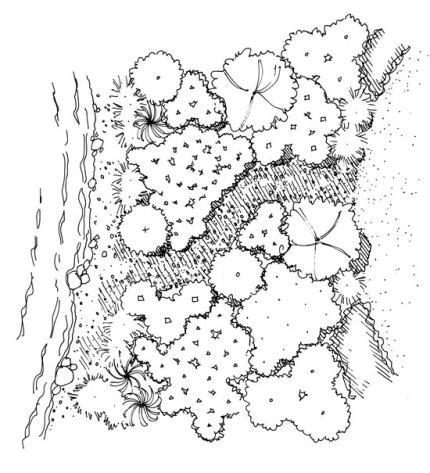
Plant Barriers
Geese have a fear of confinement you can take advantage of by the way you landscape. Shrubs, aquatic plants, and closely spaced groups of trees can be used to discourage geese if they block the birds’ pathways to grazing areas and safety, and reduce the birds’ sight lines to 30 feet.
For immediate results, plants should be at least 30 inches tall to prevent geese from seeing over them, and planted densely or in a staggered pattern to prevent geese from walking through gaps between the plants. Wide plantings (20 to 30 feet) are more effective than narrow plantings. In wide plantings, winding footpaths prevent the geese from having a direct line of sight through the planted area, yet still provide shoreline access for humans (Fig. 8).
Where space is limited, one or two rows of shrub plantings can be combined with a fence, as described below. Ideally, the fence should be installed first and the shrubs planted as closely as possible to it so that as the shrubs grow, they envelope the fence.
Geese often gain access to grazing areas by simply walking out onshore from the adjacent body of water on which they have landed. Therefore, introducing a barrier of aquatic plants along the shoreline of a water body can create both a physical and a visual barrier to geese. Barriers of native aquatic vegetation that are at least 3 feet wide and include tall material, such as bulrush (Scirpus spp.), are most effective (Fig. 9).
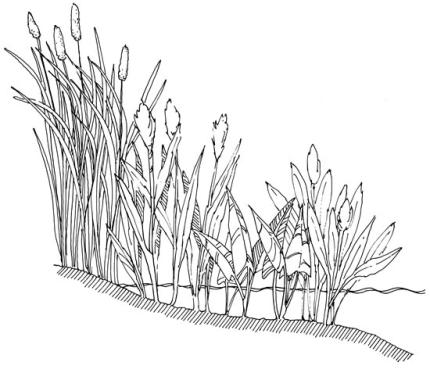
If the limiting factor is the absence of an area on which to establish the new aquatic planting, constructing such an area can help. In man-made water bodies, cutting and filling can achieve a stable substrate on which to plant a barrier of aquatic plants. The water level of the pond, or other impoundment, can be temporality lowered to allow construction of the planting area. However, along natural water bodies, construction of a planting area can be more problematic—water levels may not easily manipulated, placing fill in deeper water is more likely to create unstable, slump-prone areas, and a permit may be required (contact you local wildlife office for permit information).
Keep New Plantings in the Ground
Newly planted sites often suffer high plant mortality due to geese pulling small plants out of the ground. If still migrating, these geese would ordinarily arrive later and there would not be such pressure on the plants. To reduce this problem, or where barriers and other control tactics are not practical:
- Place large stones around the crowns of plants.
- Insert a metal staple (used to secure jute netting) over the crown of individual plants.
- Place long lengths of wood lath over the crowns of plants planted in a row. Secure the lath with metal staples or rocks.
- The above-mentioned devices will need to stay in place for two growing seasons—longer in areas where emergent plants are being established, or where there is a lot of pressure from resident geese.
- Another approach is to use large plant material (1-gallon containers instead of 4-inch pots or plugs).The larger root ball will have a better chance of getting established during the first few growing seasons.
- Drape bird netting over groups of new plantings; check netting daily for entangled birds.
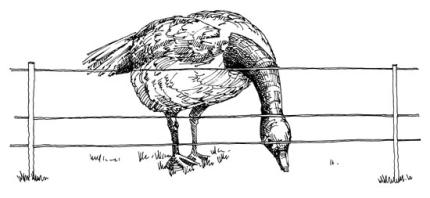
Fences
Fences can be made from woven wire, poultry netting, plastic netting, plastic snow fencing, monofilament line, or electrified wire. Fences should be at least 24 inches all (3 feet may be better), firmly constructed, and installed to prevent the geese from walking around the ends.
Regardless of the material, lower openings should be no larger than 4 inches to prevent goslings from walking under or through the fence. Thus, a fence made from five monofilament lines (at least 20-pound test) should have lines set at 4, 8, 12, 18, and 24 inches above ground.
Fences used in areas with tidal influence need to prevent geese entering the shore at all tide levels while not trapping fish. Turning field fencing upside down—moving the wider holes to the bottom—may accommodate fish passage.
Many electric fences are portable and can be set up in one or two hours and quickly taken down for storage when not in use (Fig. 10). The strands only need to be placed 4, 8, and 12 inches above the ground.
Due to the variables affecting your selection of a power source, and fence design and operation, it is best to consult a reputable dealer for the specifics regarding its use (look under “Fence Contractors” in your phone directory). Information is also available from farm supply centers. Most home improvement centers carry suitable units. Consult your local zoning office and neighborhood covenants to determine if electric fences are permitted where you live.
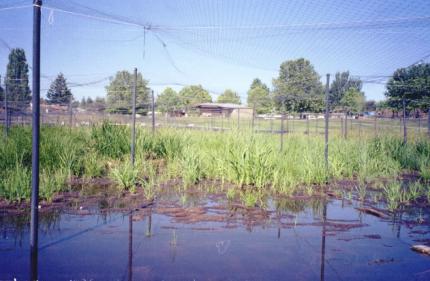
Grids and Netted Rooms
A grid or network of multiple parallel lines of wire, stainless-steel cable, twine, rope, or monofilament (50 pound test) stretched 1 to 2 feet above a water body or other area will create a flight hazard and deter geese. There should be no more than 5 feet of space between lines. If humans need to access the area under the grid, the grid can be installed high enough to accommodate them. To prevent geese from walking under the grid, install a perimeter fence as described earlier.
Attach separate lines to each vertical support (do not run the same length of wire through the entire grid) so that you will not have to rebuild the entire grid should one line break. Wherever two grid wires cross, tie the lines together to prevent rubbing and possible line breakage.
In places with large numbers of geese, and where funding is available, newly planted areas can be entirely enclosed in netting for the first few growing seasons (Fig. 11). A netted room built high enough to allow access for maintenance can be constructed using wooden vertical supports sunk in the ground, horizontal steel cable supports, and heavy-duty bird netting. Such netting is commercially available from companies that specialize in bird control. Previously used bird netting may be available from habitat restoration companies, as well as used gill netting from fisherman and fish hatcheries. The cost of new netting makes seeking out an alternative worthwhile.
Where long runs of steel cable are being installed to support netting, each line should get a separate length of cable, fitted at one end with an eyebolt, and at the other end with a turnbuckle. This will allow the cable tension to be adjusted or the cable to be removed if needed. The netting can be attached to the cable with nylon string, wire, or hog rings. Hog rings and a special tool to attach the rings are recommended for large projects.
Note: All grids, netting, and fencing material should be regularly monitored for holes, trapped wildlife, sagging, and overall effectiveness.
Harassment and Scare Tactics
Harassment and scare tactics are used to frighten Canada geese away from feeding, loafing, and resting areas where they are unwanted. Because geese learn that real physical danger isn’t associated with harassment and scare devices, the birds will quickly learn to ignore them, no matter how effective these devices may be initially. Because of this, and to take advantage of geese being neophobic (fearful of novel objects), two important rules are: (1) never rely solely on one tactic, and (2) vary the use by altering the timing and location. Harassment and frightening devices are only as effective as the person deploying them.
Harassment and scare devices are available from the Internet, at over-the-counter bird-control businesses, and at some farm and garden centers.
Harassment and scare tactics include:
Eyespot Balloons: Like most birds, geese rely more on vision than on their other senses to avoid danger, and so visual stimuli can be effective. Commercially available eyespot balloons are large, helium-filled balloons with a large, eye-like images. (Large colored spots on three sides of any helium balloon can suggest eyes.) Tether balloons on a 20- to 40-foot monofilament line attached to a stake or heavy object. The balloons should be located where the wind will not tangle them in trees and utility lines, and should be repositioned at least once per day. Two balloons should be adequate for an average size yard.
Flags and Streamers: Flags and streamers work best in areas where there is a steady wind. A simple flag design uses plastic garbage bags mounted on tall poles (Fig. 12).
In addition, mylar tape can be made into 6-foot streamers and attached to the top of 8 foot long poles. Mylar tape is silver on one side, usually red on the other, and is very shiny and reflective.
A disadvantage of Mylar tape is that it is only effective in bright sunlight and wind. Poles with flags and streamers should be repositioned once per day.
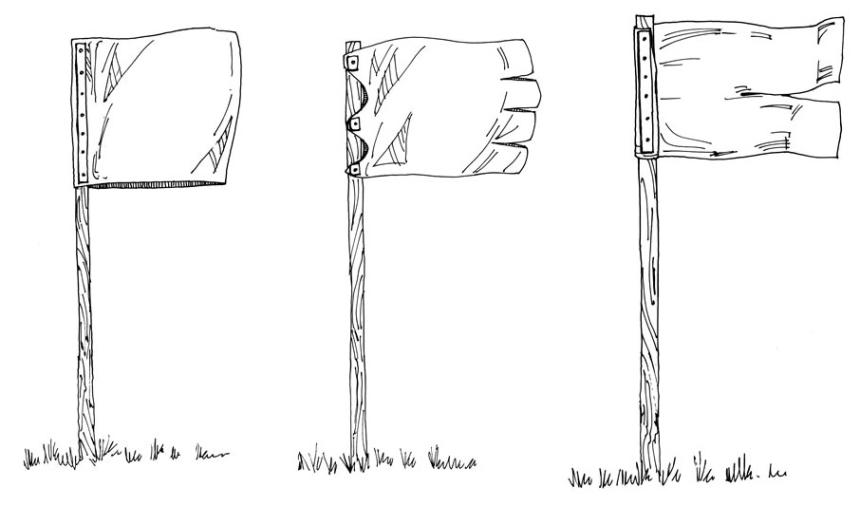
Scarecrows: Scarecrows are only effective where geese view humans as dangerous predators, such as rural areas where they are hunted. Scarecrows can be made out of almost any material; however, the design should include movement, bright colors (red, blaze orange, or safety yellow), and large eyes. For maximum effect, the arms and legs should move in the wind, and the scarecrow should be moved once per day.
Geese occasionally will find a swimming pool an acceptable area. Large, blow-up toy snakes are reported to work as a type of scarecrow. Simply buy two or three of these, add weights (sinkers), and put them in the pool. Streamers made of mylar tape may also work if strung across the landing zone.
Noisemaking Devices: Devices that make a loud bang can scare geese, causing them to take flight. Promptness (beginning as soon after the geese arrive as possible) and persistence are the keys to success when using these devices.
Types of noisemakers include propane cannons, blanks, and whistle bombs. Propane cannons are stationary devices that explode propane gas at irregular intervals. Shell crackers and whistle bombs are shells that are fired from a shotgun or special pistol. When fired they either scream for a distance of 50 yards, or explode. Pyrotechnics should only be used by skilled individuals who understand the dangers that these tools can pose.
Loud auditory tactics generally require permits from area police departments and may be restricted in urban areas because of noise ordinances. When such devices are used, it is important that all organizations involved in the process be kept in communication. In addition, the surrounding neighborhood should be advised of what the process is trying to accomplish.
The more geese are exposed to these fear-provoking stimuli, the faster they will become accustomed to them and ignore them. For this reason, noisemakers should be used sparingly, and propane cannons should be set so that they fire only a couple of times per hour.
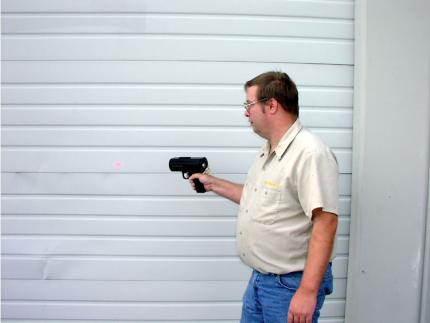
Lasers: Recent research conducted by the National Wildlife Research Center indicates that relatively low-power, long-wavelength lasers provide an effective means of dispersing geese, gulls, crows, and ravens under low light conditions, while presenting no threat to the animal or the environment (Fig. 13). The lower power levels, directivity, accuracy over distance, and silence of laser devices make them safe and effective species-specific alternatives to noisemaking devices.
Although researchers are not sure if birds see the same red spot as people, it is clear that in certain bird species the spot of laser light elicits an avoidance response. The birds view the light as a physical object or predator coming toward them and generally fly away to escape. Note: Lasers should never be aimed in the direction of people, roads, or aircraft.
At the time of writing, the cost of a laser device is still quite high. Check with dealers through the Internet and over the counter at bird-control businesses for current prices and instructions for use.
Dogs: When directed by a handler, dogs are the method of choice for large open areas such as golf courses, airports, parks, agricultural fields, and corporate parks. In residential areas, parks with continuous public use, areas bisected by roadways, and large water bodies, dog use may not be appropriate.
Results are often immediate. After an aggressive initial use (several times a day for one or two weeks), geese get tired of being harassed and will use adjacent areas instead.
A dog can be tethered to a long lead (which may require relocating the dog and tether frequently to cover more area), be allowed to chase and retrieve a decoy thrown over a large flock of geese, or be periodically released to chase the birds (if this is not against leash laws).
While the wolflike gaze of border collies is frightening to geese, these dogs rarely harm them. These dogs can be purchased already trained, or be trained; however, it is also possible to hire a border collie “service.”
Other breeds of dogs can also do the job. It is recommended that they be from proven working stock, preferably with prior experience with or exposure to live animals, particularly birds.
Chemical Repellents: Taste-aversion products and other chemical repellents are unobtrusive, may be applied directly to the problem area, and will not permanently harm the geese. Drawbacks to repellents include the high costs of covering large areas, the need for frequent application in rainy areas and during the growing season, odors associated with the few registered products, and their negative influence on the behavior of other wildlife.
If geese have used the area in the past, apply repellent before their return. Carefully read and follow all label and technical directions.
Lethal Control
If the above nonlethal control efforts are unsuccessful and the damage situation persists, lethal control may be an option. Lethal control techniques include legal hunting, shooting out of season by permit, egg destruction by permit, and euthanasia of adults by government officials.
Public Health Concerns
Canada geese are not considered to be a significant source of any infectious disease transmittable to humans or domestic animals, although their droppings are increasingly cited as a cause for concern in controlling water quality in municipal lakes and ponds.
Swimmers itch (schistosome or cercarial dermatitis) is caused by a parasite that can be spread by goose droppings, but does not mature or reproduce in humans. Recommendations to reduce the risk of swimmers itch are to: (1) vigorously towel off immediately upon exiting the water (including under bathing suits), and (2) take a soapy shower immediately after exiting the water.
If you do get the itch, a topical rash cream should alleviate some of the itching, and the rash should clear up within a week. If you have concerns or questions, contact a physician.
Legal Status
Canada geese are protected under federal and state law and a hunting license and open season are required to hunt them. Where lethal control of Canada geese is necessary outside of hunting seasons, it should be carried out only after the above nonlethal control techniques have proven unsuccessful and only under permits issued by the U.S. Fish and Wildlife Service. Currently, the only agency permitted for lethal removal is the U.S. Department of Agriculture’s Wildlife Services.
Additional Information
- Centers for Disease Control and Prevention
- Habitat Modification and Canada Geese:
Techniques for mitigating human/goose conflict in urban and suburban environments - Seattle Audubon’s Birds of Washington State
- Wildlife Control Supplies
